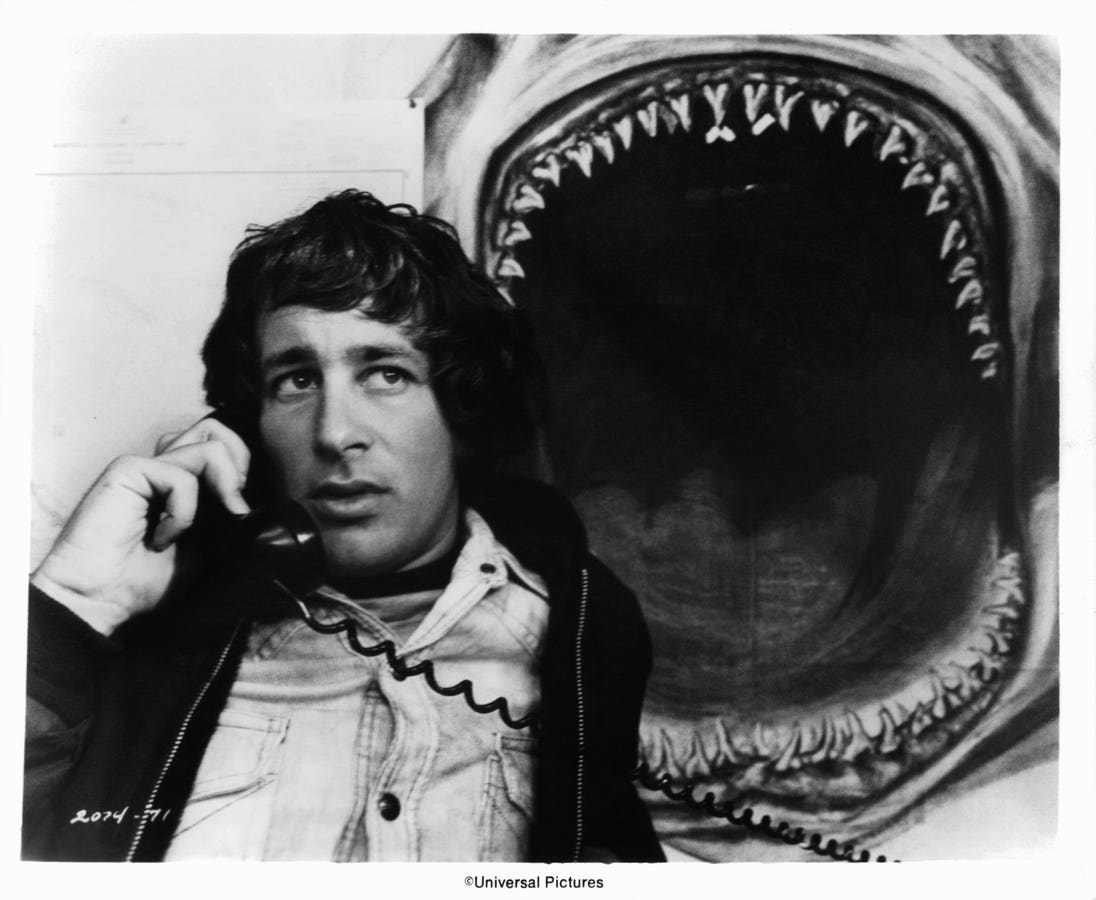Steven Spielberg on set of the film ‘Jaws’, 1975. (Photo by Universal/Getty Images)
When Jaws hit theaters in 1975, it did more than just cause moviegoers to throw their soda and popcorn up in the air in fear. It did more than cause audience members to think twice about going into “shark infested waters.” No… it ignited a wave of fear that has rippled across not only the ocean but through generations. Now, 50 years later, endurance swimmer Lewis Pugh is diving back into the legacy of the infamous movie, literally, with a 62-mile (100-kilometer) swim around Martha’s Vineyard, the island where the iconic film was shot. His goal? Not to break records or chase fame, but challenge the fear that Jaws planted in the minds of… well, anyone who is afraid of sharks because of the hit film. Fifty years after Jaws made Martha’s Vineyard a household name for all the wrong reasons, Pugh is hoping to tell a new story where sharks aren’t the villains, but the victims.
“It lives to kill. A mindless eating machine. It will attack and devour anything. It is as if God created the devil and gave him jaws.” At least, that’s what the narrator in the trailer for the movie says of sharks. But sharks play a critical role in maintaining ocean health. As top predators in our watery world, they keep populations of other species in check and help balance marine food webs. Lose the sharks, and the system starts to collapse. Yet public perception has long painted them as monsters. Jaws turned a rare and tragic shark attack into a global fear, spawning decades of sensational headlines, culls, and unnecessary killings.
In the summer of 1916, a series of five shark attacks along the New Jersey coast (resulting in four deaths and one injury) shocked the public, especially since shark behavior was poorly understood at the time. Beginning with the death of Charles Vansant and culminating with bites in the seemingly safe waters of Matawan Creek, many believed these attacks were either caused by something else (many believed 10-year-old Stilwell’s died due to drowning during an epileptic fit) or caused by other animals (when an ichthyologist examined Charles Bruder’s body, it was claimed that he was killed by a killer whale). “There were all kinds of misconceptions,” Dr. George Burgess, former shark program director at the Florida Museum of Natural History, once told National Geographic. “At least one school of thought at the time was this was all stuff of rumors and fabrications.” It wasn’t until a young great white shark was caught nearby with human remains in its stomach that people began to accept sharks as potential threats. This event marked a turning point in the public’s perception of sharks. And it was this shark, and the fear sparked by these shark encounters, that laid the groundwork for the “man-eater” image that would later be amplified by Jaws. While most shark species pose little to no threat to humans, these rare attacks have overshadowed scientific reality. Even Peter Benchley, who wrote the novel the movie was based on, later regretted his portrayal. In his later years, Benchley became an advocate for sharks, using his platform to call for better protection.
Endurance swimmer Lewis Pugh is seen near the Edgartown Lighthouse on Monday, May 12, 2025, in … More
Marine biologist Greg Skomal acknowledged the complicated legacy of Jaws, saying it frightened people, sure, but it also sparked interest in marine life and inspired a generation (or two) of ocean scientists. Over the decades, attitudes have begun to shift from panic and fear to curiosity and respect. But perception alone isn’t enough. Shark populations are still declining, with three-quarters (75%) of sharks and rays now qualify as threatened with extinction under the International Union for Conservation of Nature. Changing hearts and minds is the first step, but action needs to follow.
That’s where Pugh’s swim fits in. He hopes that by returning to the place where the fear began, he can rewrite the narrative. That the swim will draw media attention to the problem, creating opportunities for public engagement, and reminding us that coexistence with sharks isn’t just possible but essential to all of us. While admiting that he is scared of sharks himself, and of jumping into the water with them, he told the Independent, “but I’m really frightened of a world without sharks. They’re essential for a healthy ocean.” That fear is backed by data: an estimated 100 million sharks are killed every year, mainly due to overfishing, the fin trade, and commercial fishing pressures. That number isn’t sustainable for species that grow slowly and reproduce infrequently.
Pugh is no stranger to pushing limits. He’s swum in every ocean, through freezing waters near glaciers, around volcanoes, and in areas known for dangerous wildlife. But this new challenge carries emotional weight. Swimming several hours a day in 47°F (8°C) water for about 12 days, he’s doing so with just trunks, a swim cap, and goggles. His safety setup includes a support boat and a Shark Shield device, which emits an electric field to deter sharks without harming them. It’s an extreme test of endurance. And if that wasn’t enough, each evening after emerging from the cold Atlantic, Pugh vows he will meet with the public to talk about shark conservation. As the United Nations’ Patron of the Oceans, Pugh sees storytelling as a powerful conservation tool. And he believes few stories are more potent than a lone swimmer facing the cold, open ocean with nothing between him and the wildlife below.
The original Jaws film showed us what happens when fear takes the lead. Pugh’s swim offers an alternative ending, where protection replaces panic and persecution. And where future generations might grow up respecting the ocean’s most iconic predators, rather than fearing them. At least, that’s his goal.







